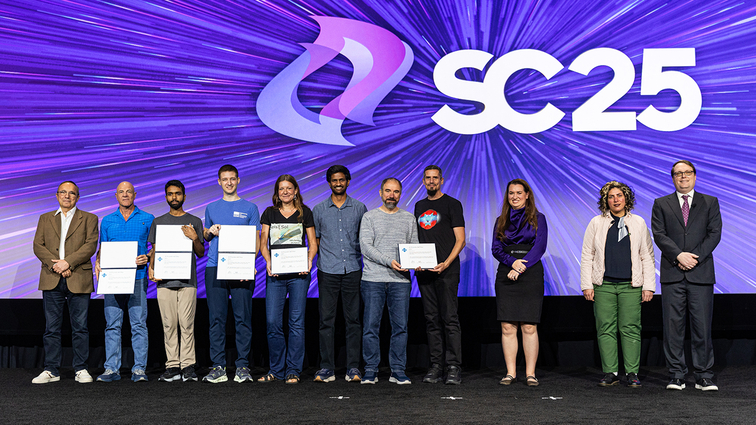
Researchers from Lawrence Livermore National Laboratory (LLNL), the University of Texas at Austin’s Oden Institute, and the Scripps Institution of Oceanography at the University of California San Diego have been awarded the 2025 Association for Computing Machinery (ACM) Gordon Bell Prize. Announced on November 20 at the International Conference for High Performance Computing, Networking, Storage, and Analysis (SC25) in St. Louis, the award recognizes their development of a real-time tsunami early-warning framework powered by the world’s fastest supercomputer, El Capitan.
The Gordon Bell Prize, considered the pinnacle of achievement in high-performance computing, honors innovations that significantly advance computational performance, scalability, and scientific impact on critical global issues. The team’s groundbreaking work demonstrated for the first time that real-time, physics-based tsunami forecasting is feasible at the exascale level, paving the way for more rapid and reliable early-warning systems for coastal communities.
Revolutionizing Tsunami Forecasting
In their winning paper, the researchers showcased a framework that integrates real-time sensor data with full-physics modeling and uncertainty quantification, enabling decisions to be made before a tsunami reaches the shore. Omar Ghattas, a professor of mechanical engineering and principal faculty at the Oden Institute, emphasized the significance of this achievement.
“For the first time, we can combine real-time sensor data with full-physics modeling and uncertainty quantification – fast enough to make decisions before a tsunami reaches the shore,” said Ghattas. “It is a tremendous honor for our team to receive this highest recognition in the field of supercomputing.”
The team tackled the challenge by creating innovative supercomputing algorithms for digital twins, which infer seafloor motion from real-time pressure sensor data. This data is then used to predict the destructive tsunami waves, executing the entire process in a fraction of a second—10 billion times faster than traditional algorithms.
The Role of El Capitan
El Capitan, LLNL’s exascale supercomputer, played a crucial role in resolving wave simulations to the full margin of the Cascadia subduction zone in the Pacific Northwest. According to Tzanio Kolev, a computational mathematician at LLNL, the project represents the culmination of years of research in numerical methods, high-order modeling, and exascale computing.
“Our goal was to show that physics-based simulation can deliver near-instant results for critical applications like tsunami warnings,” Kolev explained. “By combining real-time sensor data with exascale modeling, we demonstrated a practical path toward next-generation warning systems.”
Tsunamis are among the most devastating natural hazards globally, and warning centers often have mere minutes to determine if an offshore earthquake will generate a life-threatening wave. Current systems rely on simplified approximations and sparse instrumentation, which may not capture the complex physics of tsunami generation and propagation. These limitations can lead to false alarms, underestimated risks, or delays that reduce evacuation time.
Innovative Approaches and Future Implications
El Capitan’s computational power supported the largest-ever unstructured-mesh finite-element simulation, resolving 55.5 trillion degrees of freedom with LLNL’s open-source MFEM finite element library. This capability allowed researchers to reconstruct seafloor motion, infer earthquake characteristics, and forecast tsunami arrival times and wave heights in seconds, providing quantified confidence estimates for emergency managers.
The Oden Institute led the project with innovations in inverse algorithms, enabling real-time inference of seafloor deformation from offshore pressure sensor data. Stefan Henneking, a research associate at the Oden Institute, highlighted the technical challenges overcome during the project.
“The biggest technical challenge in creating the Cascadia digital twin was the enormous problem size combined with the need for providing forecasts in real time,” said Henneking. “Overcoming this challenge required novel parallel inversion algorithms and exploitation of leading-edge GPU supercomputers.”
The Scripps Institution of Oceanography contributed essential expertise in tsunami science and ocean-floor dynamics, ensuring the modeling pipeline aligned with real-world warning center requirements. Alice-Agnes Gabriel, an earthquake seismologist at Scripps, noted the broader implications of their work.
“Our work shows that physics-based models of earthquakes and tsunami generation are now fast enough to guide real-time response, which not only improves early warning for the Pacific Northwest but also points the way toward global, physics-based earthquake and tsunami early-warning systems,” Gabriel stated.
Looking Ahead
The researchers plan to continue refining their method, exploring integration with operational tsunami warning centers, and expanding to cover a broader range of geophysical hazards. They also aim to extend the modeling approach to additional regions and improve the fidelity of the digital twin.
Rob Neely, LLNL Weapon Simulation and Computing Associate Director, emphasized the significance of the Gordon Bell Prize and the project’s impact.
“Winning the Gordon Bell Prize is an extraordinary recognition of what this team has achieved,” Neely said. “This project highlights the versatility of El Capitan as a tool for real-world impact and shows what happens when computational innovation meets real-world urgency.”
Other contributors to the project included Veselin Dobrev and John Camier of LLNL, and Sreeram Venkat and Milinda Fernando of the UT Oden Institute. Their collective efforts underline the potential of exascale computing to address urgent global challenges, demonstrating the convergence of high-fidelity modeling, advanced numerical methods, and cutting-edge hardware for societal benefit.






